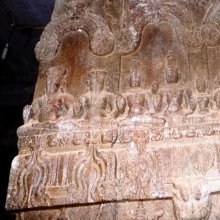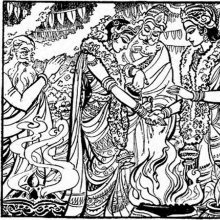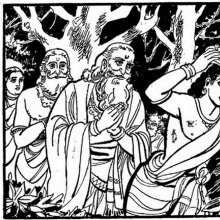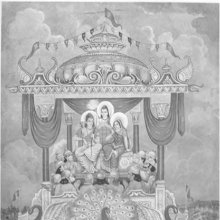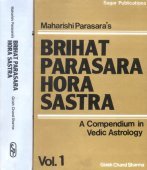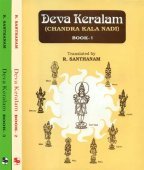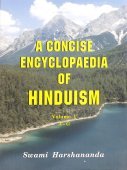Vasishta, Vāsiṣṭa, Vasiṣṭa, Vashishta: 8 definitions
Introduction:
Vasishta means something in Hinduism, Sanskrit. If you want to know the exact meaning, history, etymology or English translation of this term then check out the descriptions on this page. Add your comment or reference to a book if you want to contribute to this summary article.
The Sanskrit terms Vāsiṣṭa and Vasiṣṭa can be transliterated into English as Vasista or Vasishta, using the IAST transliteration scheme (?).
Images (photo gallery)
In Hinduism
Vedanta (school of philosophy)
Source: Shodhganga: Siva Gita A Critical StudyVasiṣṭa (वसिष्ट) or Vasiṣṭagītā refers to one of the sixty-four Gītās commonly referred to in Hindu scriptures.—Gītā is the name given to certain sacred writings in verse (often in the form of a dialogue) which are devoted to the exposition of particular religious and theosophical doctrines. Most of these Gītās [i.e., Vasiṣṭa-gītā] originate from the Mahābhārata or the various Purāṇas.
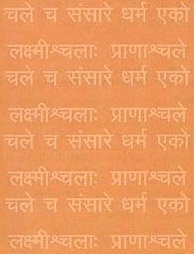
Vedanta (वेदान्त, vedānta) refers to a school of orthodox Hindu philosophy (astika), drawing its subject-matter from the Upanishads. There are a number of sub-schools of Vedanta, however all of them expound on the basic teaching of the ultimate reality (brahman) and liberation (moksha) of the individual soul (atman).
General definition (in Hinduism)
Source: Apam Napat: Indian MythologyVasishta is the chief of the SaptaRishis, the seven great sages. He is the preceptor of the Ishvahu clan, which is also refered to as the Surya dynasty. He was thus the guru of Rama and Rama's father Dasharatha. He is the son of Brahma and is his ManasaPutra (Wish-born-son).
His wife was Arundhati, who is one of the stars. In a typical Hindu wedding, there is a ritual where the bride is made to gaze at Arundhati in the heavens, emphasizing Arundhati's role as an ideal wife. Some accounts also say that the wife of Vasishta was Urja, a daughter of Daksha.
Vasishta also posesses the divine cow Nandini. This cow is the offspring of Indra's cow Kamadhenu, and was given as a gift to Vasishta by Indra. Like her mother, this cow is also capable of yielding anything desired by a seeker. Vasishta is also famous for his struggle with Vishwamitra for being the greatest sage of all time.
Languages of India and abroad
Sanskrit dictionary
Source: DDSA: The practical Sanskrit-English dictionaryVāsiṣṭa (वासिष्ट).—Blood.
Derivable forms: vāsiṣṭam (वासिष्टम्).
Source: Cologne Digital Sanskrit Dictionaries: Shabda-Sagara Sanskrit-English DictionaryVāsiṣṭa (वासिष्ट).—n.
(-ṣṭaṃ) Blood.
Source: Cologne Digital Sanskrit Dictionaries: Monier-Williams Sanskrit-English DictionaryVāsiṣṭa (वासिष्ट):—n. blood, [cf. Lexicographers, esp. such as amarasiṃha, halāyudha, hemacandra, etc.] ([probably] [wrong reading] for vāsiṣṭha; See next).
Source: Cologne Digital Sanskrit Dictionaries: Yates Sanskrit-English DictionaryVāsiṣṭa (वासिष्ट):—(ṣṭaṃ) 1. n. Blood.
Source: DDSA: Paia-sadda-mahannavo; a comprehensive Prakrit Hindi dictionary (S)Vaśiṣṭa (वशिष्ट) in the Sanskrit language is related to the Prakrit words: Vasiṭṭha, Vāsiṭṭha.
[Sanskrit to German]
Sanskrit, also spelled संस्कृतम् (saṃskṛtam), is an ancient language of India commonly seen as the grandmother of the Indo-European language family (even English!). Closely allied with Prakrit and Pali, Sanskrit is more exhaustive in both grammar and terms and has the most extensive collection of literature in the world, greatly surpassing its sister-languages Greek and Latin.
See also (Relevant definitions)
Starts with: Vasishtagita.
Full-text (+10): Vasittha, Arundhati, Vasishtha, Kagapusundar, Urja, Hatavashishta, Trishanku, Kaitava, Atmaghata, Matanga, Pancasiddhantika, Parashara, Nandini, Saptarshi, Purna, Shakti, Kamadhenu, Avashishta, Madayanti, Vasishtagita.
Relevant text
Search found 31 books and stories containing Vasishta, Vashishta, Vāsiṣṭa, Vasista, Vasiṣṭa, Vaśiṣṭa, Vāśiṣṭa; (plurals include: Vasishtas, Vashishtas, Vāsiṣṭas, Vasistas, Vasiṣṭas, Vaśiṣṭas, Vāśiṣṭas). You can also click to the full overview containing English textual excerpts. Below are direct links for the most relevant articles:
Arundhati: A Character Study < [January 1959]
Is There Bhakti Rasa in Mahabharata? < [January – March, 1997]
Kamba Ramayana < [October – December, 1997]
Bhagavatpadabhyudaya by Lakshmana Suri (study) (by Lathika M. P.)
The Question of Identity < [Chapter 3 - References to Śaṅkara’s Philosophy]
Rig Veda (translation and commentary) (by H. H. Wilson)
Expiatory Rites in Keralite Tantra (by T. S. Syamkumar)
6.1. Expiatory Rites in Dharmasūtras (Introduction) < [Chapter 1 - Expiatory Rites: Concept and Evolution]
6.1.4. Expiatory Rites in Vasiṣṭha-dharmasūtra < [Chapter 1 - Expiatory Rites: Concept and Evolution]
4.2. Diseases and Expiatory Rites < [Chapter 1 - Expiatory Rites: Concept and Evolution]
Shaiva Upanishads (A Critical Study) (by Arpita Chakraborty)
18. Praise of the Rosary of Akṣa-beads < [Chapter 4 - A Critical approach to Rudrākṣa based on Śaiva Upaniṣads]
Tiruvaymoli (Thiruvaimozhi): English translation (by S. Satyamurthi Ayyangar)
Pasuram 8.5.7 < [Section 5 - Fifth Tiruvaymoli (Mayak kutta)]
Pasuram 3.8.2 < [Section 8 - Eighth Tiruvaymoli (Mutiyane)]
Pasuram 2.7.4 < [Section 7 - Seventh Tiruvaymoli (kecavan tamar)]
Related products
